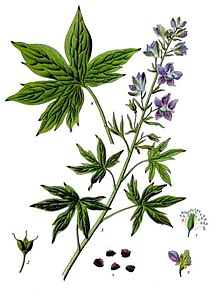Delphinium staphisagria
| Delphinium staphisagria | |
|---|---|
 |
|
| Scientific classification | |
| Kingdom: | Plantae |
| (unranked): | Angiosperms |
| (unranked): | Eudicots |
| Order: | Ranunculales |
| Family: | Ranunculaceae |
| Genus: | Delphinium |
| Species: | D. staphisagria |
| Binomial name | |
|
Delphinium staphisagria L. |
|
Delphinium staphisagria is a species of Delphinium, or larkspur, of the family Ranunculaceae. This plant is also known as Lice-Bane or Stavesacre. It is described botanically as a stoutly-stemmed, hairy biennial with large palmate leaves up to 6 inches (15 cm) across. The flowers are mauve-blue to blue, short-spurred, and up to 1 inch (2.5 cm) across, occurring in racemes. The plant grows to a height of 4–5 feet. It grows throughout the Mediterranean. The dark-colored, wrinkled seeds of D. staphisagria are characteristically quite large (~5x6 mm), and it is likely that the species name, which translates to "wild raisin" (classical Greek: σταφὶς ἀγρία) is based on their appearance. This name-derivation seems to have been arrived at independently by a modern horticulturalist, David Bassett, who also gives a detailed account of his experiences in growing this species. All parts of this plant are highly toxic and should not be ingested in any quantity.
The use of herbal preparations made from D. staphisagria seeds for destroying body-lice has been recognized since antiquity. The Greek physician Dioscorides and the Roman historian Pliny are most often mentioned in this context, and in assessing this classical literature, Barton and Castle expressed the opinion that Dioscorides's description of staphis agria was consistent in most respects with the plant they knew as Delphinium staphisagria. One of the founders of American pharmacognosy, John Uri Lloyd, writing in his famous Pharmacopeia, also cited references to the use of D. staphisagria preparations in the writings of Nicander and Crescenzio.
A Delphinium preparation of some sort (most likely from D. staphisagria) was apparently a standard issue to British troops at the Battle of Waterloo in 1815.
As noted above, preparations made from D. staphisagria (apparently principally from the seeds) were used as a pediculicide throughout the last two millennia. Maud Grieve, in her famous Herbal, written in 1931, refers to stavesacre as being a "vermifuge" and "vermin-destroying", as well as to its parasiticidal properties. She also mentions that it is "violently emetic and cathartic".
...
Wikipedia
